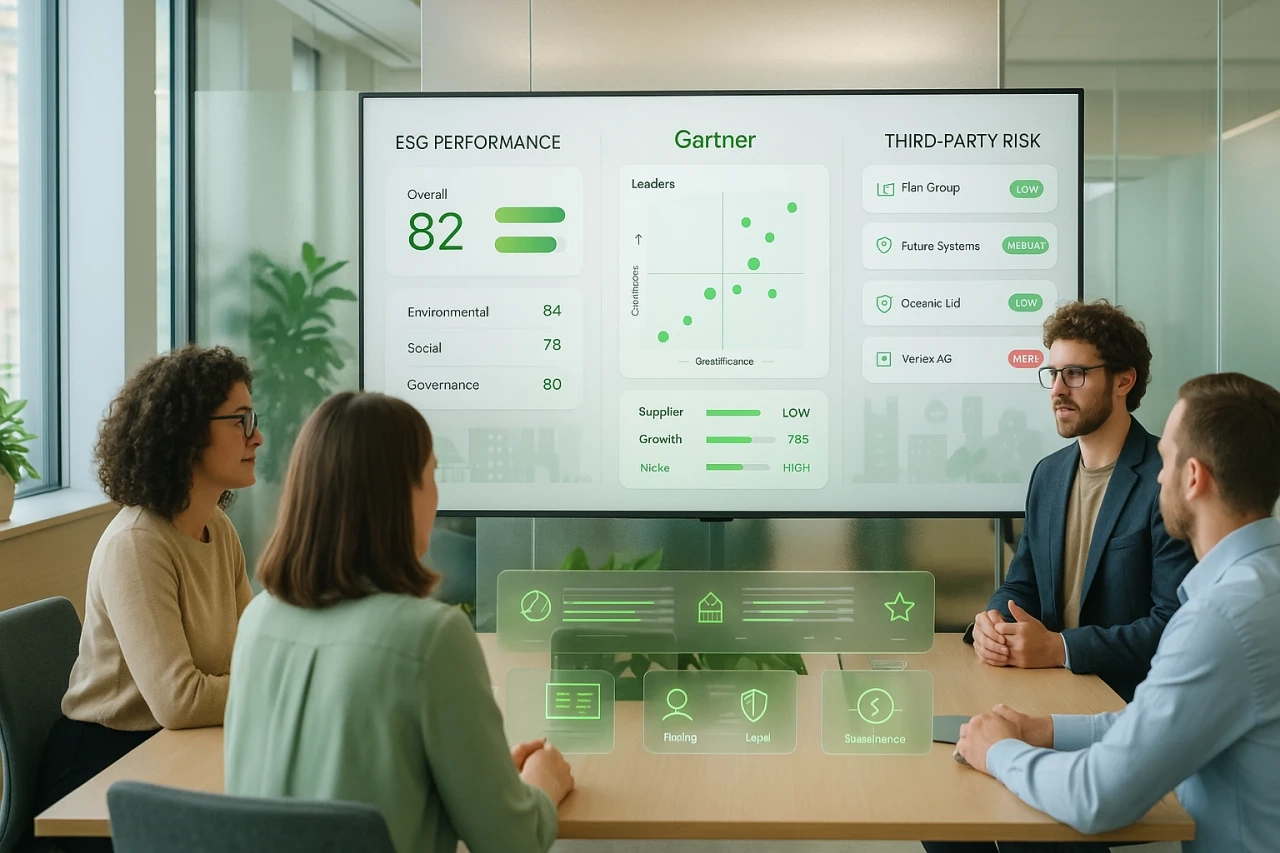How to Select Priority KPIs or KRIs for Third-Party Monitoring

In third-party governance, tracking key performance indicators (KPIs) has become a central component in meeting rising expectations for operational resilience. Operations managers and compliance officers now expect dynamic dashboards that clearly rank the risks associated with each third-party partner while taking into account industry specifics and risk profiles.
According to a Grant Thornton study, only 45% of companies consider themselves compliant in third-party evaluation, highlighting the urgent need to optimize monitoring processes. To prevent these dashboards from becoming bureaucratic or exacerbating supplier fatigue, it’s essential to structure indicator mapping according to coherent priorities aligned with sector exposure and potential business impact.
Establishing Core KPIs: Cross-Functional Supplier Performance Management
To build a relevant operational dashboard, certain metrics are essential across all sectors. These ensure an objective and regular collaborative evaluation of third-party relationships, laying the groundwork for operational resilience.
These cross-functional KPIs should help identify early warning signals, trigger targeted alerts, and feed readable reports for IT, compliance, or procurement stakeholders.
From KPIs to KRIs
Key Risk Indicators (KRIs) enhance third-party monitoring, particularly for suppliers, by offering risk-oriented metrics. Closely tied to Third-Party Risk Management (TPRM), KRIs help anticipate potential issues, detect weak signals, and respond swiftly to threats. By incorporating both internal and external data, these indicators enable dynamic, targeted tracking tailored to the specific risks of each third-party category.
Essential Generic Indicators
A few core KPIs should appear in any operational dashboard:
On-time delivery
Tracks logistical punctuality, especially critical in manufacturing and distribution, and reflects supply chain and customer satisfaction impact.
Product or service quality
Measures non-conformities upon receipt or during regular use, helping anticipate reputational risks and quality-related costs.
Supplier compliance
Monitors adherence to regulatory requirements (e.g., DORA, NIS 2) and internal standards. With Gartner predicting 45% of cyberattacks will come from third parties by 2025, this is a growing concern.
Cost management and profitability
Compares initial contract prices with actual costs, including penalties or overruns.
Service rate
Indicates the percentage of orders delivered without major issues or delays—a snapshot of operational reliability.
Proactive KPI/KRI monitoring requires formal periodic reviews and alert thresholds adapted to the criticality of outsourced services. In manufacturing, for example, non-conformity rates per component category are reviewed quarterly, with automatic alerts triggered beyond a 3% threshold—an approach informed by industrial clients like TELT.
To optimize your monitoring, learn how to build an effective third-party risk dashboard.
Adapting Indicators to Sector-Specific Needs
Some environments require fine-tuning of standard KPIs to target what truly matters for each business context. This sector-based customization transforms a generic dashboard into a precise decision-making tool.
- Retail and e-commerce focus on order and invoice tracking, stockout rates, customer return rates, and urgent order processing times. These indicators directly reflect the customer experience and supply chain efficiency.
- Industry includes machine availability, preventive maintenance timelines, and production indicators. Safety incidents (ICPE) are major KPIs, especially for classified sites where failures may lead to regulatory sanctions.
- The public sector emphasizes procurement traceability, transparency in public tenders, and frequency of invoice audits. With 450,000 third parties evaluated globally, Aprovall’s expertise shows that public entities prioritize document compliance and regular legal certifications.
- Construction builds its governance around site safety KPIs, delivery milestone tracking, and subcontractor documentation compliance. This sectoral focus enables the creation of personalized dashboards perfectly aligned with each sector’s main operational challenges.
Prioritizing KPIs: A Sector-Based Risk Mapping Approach
Prioritizing KPIs goes beyond distinguishing what’s measurable—it’s about mapping potential indicators and focusing reporting on those that reveal real exposure to failure or non-compliance.
This prioritization depends on both the third party’s criticality to core operations and its supplier performance history. Thus, a third-party governance manager gains agility and can swiftly mobilize resources when deviations are flagged by the monitoring platform.
Criteria for Ranking KPIs
This hierarchy is built using a proven methodology based on:

Third-party risk profile
Involvement in critical processes, access to sensitive data, key supply chain role. Evaluation relies on dynamic risk scoring.
Business sensitivity
Direct impact on product/service quality for end-users or on overall supply chain compliance.
Incident history
Records of non-quality, repeated delays, cost deviations, or documented issues in inventory or logistics systems.
The goal is to weight each KPI according to the provider’s criticality and service type, then define alert thresholds based on the expected severity of consequences.
Sector-Based Dashboard Examples
Experience shows that effective dashboards highlight 3–5 core KPIs per third-party category. Examples:
- Manufacturing: Service rate, average lead time for critical parts, return count, and raw material supply reliability.
- Construction/infrastructure: Milestone adherence, partner accident rates, document compliance volume, budget vs actual spending. Learn more in our third-party risk mapping guide.
- Public sector: On-site intervention time, dispute resolution rate, compliance with public procurement, regular certification audits.
- Retail: Multi-site stockouts, partial deliveries, customer complaint resolution, supplier payment delay trends.
Each dashboard includes visual gauges tied to alert thresholds, offering an actionable and synthetic view—avoiding distraction by less useful indicators.
Setting Sectoral Alert Thresholds: Enabling Quick Action
Predefined alert thresholds turn a static KPI monitoring interface into a real decision-making tool. Instead of focusing on numbers, dashboards spotlight risk situations and target third parties needing immediate action.
Setting thresholds requires coordination between central governance, operational teams, and TPRM leads, balancing organizational risk appetite and real-world conditions.
Best Practices for Setting Thresholds
Based on field experience and Aprovall’s client base:
- Industry: Over 2% late deliveries triggers a quality review.
- Public sector: More than one invoice rejection per month requires immediate partner training.
- Construction: Two safety incidents per quarter trigger temporary suspension until compliance.
- Food retail: Any supply duplication triggers manual review by procurement.
These evolving thresholds reflect partnership depth, performance history, and market context—ensuring efficient focus where ROI is highest.
Enhancing Collaboration Through KPI Visualization
Adapted dashboards encourage constructive collaboration with third parties, offering shared views of commitments and progress. This transparency increases engagement during collaborative evaluations and reduces supplier fatigue via clearly contextualized expectations.
Modern tools automatically collect critical indicators, merging ERP, logistics, and accounting data into a single actionable view for all third-party governance stakeholders.
AI-powered solutions like Aprovall’s automate compliance document analysis and enhance KPIs with real-time data. Supported by ISO 27001/27701 dual certification, this technology ensures data reliability while reducing administrative burden.
These articles might interest you
-
 12 May 2025Understanding the Impact of the NIS 2 Directive on the Supply ChainSecteurThe modern supply chain forms the backbone of European economies, orchestrating complex flows between partners, suppliers, and subcontractors. With the acceleration of digitalization, this growing interconnection exposes organizations to unprecedented cyber vulnerabilities. The NIS 2 directive, effective since October 2024, is revolutionizing the cybersecurity approach by mandating collaborative evaluation of third-party partners. This regulatory shift […]
12 May 2025Understanding the Impact of the NIS 2 Directive on the Supply ChainSecteurThe modern supply chain forms the backbone of European economies, orchestrating complex flows between partners, suppliers, and subcontractors. With the acceleration of digitalization, this growing interconnection exposes organizations to unprecedented cyber vulnerabilities. The NIS 2 directive, effective since October 2024, is revolutionizing the cybersecurity approach by mandating collaborative evaluation of third-party partners. This regulatory shift […]Read more
-
 14 May 2025Environmental Criteria for Third-Party Partner EvaluationSecteurMore and more companies are incorporating environmental preservation into their overall strategy. Whether through sustainable practices or compliance with the CSRD (Corporate Sustainability Reporting Directive), these organizations aim to reduce their ecological footprint. The evaluation of suppliers plays a crucial role in this process, using various environmental criteria to ensure a responsible supply chain. What […]
14 May 2025Environmental Criteria for Third-Party Partner EvaluationSecteurMore and more companies are incorporating environmental preservation into their overall strategy. Whether through sustainable practices or compliance with the CSRD (Corporate Sustainability Reporting Directive), these organizations aim to reduce their ecological footprint. The evaluation of suppliers plays a crucial role in this process, using various environmental criteria to ensure a responsible supply chain. What […]Read more
-
 19 June 2025Scope 3 Data Collection Methodology: Structuring Third-Party Governance for CSRD ComplianceSecteurThe transition toward robust environmental reporting, particularly under the CSRD framework, requires both public and private organizations to thoroughly evaluate their indirect emissions, also known as Scope 3. This obligation goes far beyond regulatory compliance. In public housing, government procurement, industrial or retail sectors, the ability to structure solid third-party governance is now critical to the overall performance of an […]
19 June 2025Scope 3 Data Collection Methodology: Structuring Third-Party Governance for CSRD ComplianceSecteurThe transition toward robust environmental reporting, particularly under the CSRD framework, requires both public and private organizations to thoroughly evaluate their indirect emissions, also known as Scope 3. This obligation goes far beyond regulatory compliance. In public housing, government procurement, industrial or retail sectors, the ability to structure solid third-party governance is now critical to the overall performance of an […]Read more
-
 11 June 2025Decoding Gartner Evaluation Criteria for European Third-Party Governance PlatformsSecteurAs third-party governance becomes a cornerstone of operational resilience for organizations, Gartner’s Magic Quadrant evaluation standards stand out as an essential benchmark. However, their application within the European market demands a methodical adaptation to incorporate regulatory compliance with DORA, NIS 2, and CSRD, while ensuring data sovereignty and security. This dual imperative shapes how decision-makers in the […]
11 June 2025Decoding Gartner Evaluation Criteria for European Third-Party Governance PlatformsSecteurAs third-party governance becomes a cornerstone of operational resilience for organizations, Gartner’s Magic Quadrant evaluation standards stand out as an essential benchmark. However, their application within the European market demands a methodical adaptation to incorporate regulatory compliance with DORA, NIS 2, and CSRD, while ensuring data sovereignty and security. This dual imperative shapes how decision-makers in the […]Read more



